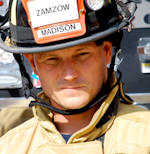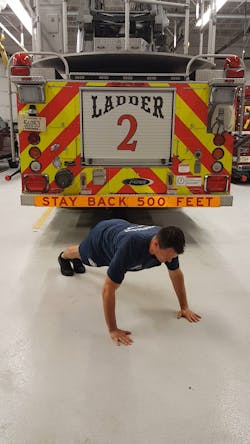Health & Wellness: 6 Bodyweight Exercises for Firefighters
While we’re all excited that summer has arrived, the warmer weather can bring on a litany of fun activities that, perhaps too conveniently, cut into our workout time. And let’s face it, the most common reason we skip our workouts is a lack of time, an excuse that’s closely followed by lack of equipment.
One way to ensure that you stay on track with your fitness regime is to have a simple set of go-to exercises that don’t require a lot of time or equipment. These workouts and exercises can be especially handy during longer shifts or in firehouses that lack fitness equipment.
Bodyweight exercises are perfect for this. They offer a simple, effective way to improve mobility, balance, strength and even cardiovascular fitness. Besides that, they are versatile, have many variations, can be done anywhere with minimal room and are easy to perform (with some practice). Ultimately, these exercises are a great way to improve performance on and off the fireground.
Following are six great bodyweight exercises for firefighters that will improve performance and keep you fit for duty this summer.
Spidermans
The hip flexors are a group of muscles that connect your femur (thigh bone) to your pelvis (hip bone) and lower back. Due to the nature of work firefighters do—climbing, lifting, crawling and sitting—these muscle groups tend to be tight and inflexible. The Spiderman stretch is a great way to keep the hip flexors strong and flexible, which will ultimately reduce your risk of injury and back pain. You can perform the Spiderman exercise as an active movement to prepare your body for training or a workout.
To perform the Spiderman, start in the push-up position, then step forward with your left foot and place it outside of your left hand. Try to drive the hips forward toward the floor, and hold that position for 3 to 5 seconds. Do five to six repetitions with each leg.
There are some great variations with the Spiderman exercise; for example, you can add a reach with one arm toward the sky or add a push-up between switching legs.
Plank
The plank is one of the best exercises to flatten and tone the stomach. It’s also one of the of the best exercises for core conditioning because it works the glutes and hamstrings, supports proper posture and improves balance. If you’ve never tried one, a plank may look easy—almost too easy to be beneficial—but this is deceiving. While getting into the proper form is straightforward, holding the position takes strength and endurance in your abs, back and core.
A good plank is all about alignment; that is, your entire body should be in a perfectly straight line, with ears, shoulders, hips, knees and ankles on the same plane.
To properly execute a plank, hold your elbows directly under your shoulders and place your wrists in line with your elbows. Next, extend your legs and tuck your toes under your feet. Press your forearms into the ground, and push your hips up until your body is in a straight line. In this position, brace your abdominals. Contract them like expecting a punch in your stomach, squeeze your gluteal (tailbone) and thigh muscles simultaneously while continuing to breathe normally. Try to hold the plank for at least 20 to 30 seconds and work up to holding for 1–2 minutes.
Although the plank is held while balancing on your elbows and toes, it can be modified to suit all fitness levels. There are so many great workouts that incorporate the classic plank. Novices can start on their knees instead of their toes, while intermediate level trainees can try to play around with different variations like the side plank, balancing plank and rotating planks.
Prisoner squats
Leg strength is vital for firefighters. We routinely carry heavy objects up and down stairs and ladders, and drag heavy hose around. So obviously, we want to incorporate exercises that address these demands. This makes prisoner squats an obvious choice for this list.
Weighted or unweighted, the prisoner squat builds hip and leg strength, and improves posture and your overall level of fitness. One of the great things about squats is how versatile they are. Once you’re able to do a fair number of prisoner squats with perfect form, there are many variations you can use to make the exercise more challenging.
To perform the prisoner squat, stand with your feet hip-width apart and place your fingers on the back of your head, pulling your elbows and shoulders back and sticking your chest out. Lower your body as far as you can by pushing your hips back and bending your knees, keeping your torso upright and your core tight. Pause, then slowly push yourself back to the starting position. Try not to rush each rep and keep your elbows back.
Try to perform 10 to 20 perfect reps. As you build your leg strength, you may want to increase the pause at the bottom part of the rep or add a jump at the end of each rep.
Push-ups and inverted rows
Pushing and pulling hose are universal skills that every firefighter is required to perform on the fireground. The muscle groups required to complete these movements are like those required to complete push-ups and pull-ups. I grouped push-ups and inverted rows here because you want to always work both pushing and pulling exercises to keep your muscles in balance.
Push-ups are a standard exercise that we all know. It doesn’t get more basic than using your arms to push your body up from the ground. When practiced perfectly, the push-up also happens to be one of the best full-body exercises around, and there are many great challenging progressions and variations.
The inverted row is the opposite motion, and it is a great exercise to work grip strength as well as the muscles of the upper back and biceps. As with push-ups, the goal of the inverted row is to keep your body in a straight line from the top of your head to your ankles, which also helps to strengthen the muscles of the core and lower back. This exercise requires some fixed point in which you can use to pull from. Webbing, a towel or a TRX suspension trainer are great options for this exercise.
To perform a good push-up, get into plank position, with your hands under but slightly outside of your shoulders. Lower your body until your chest nearly touches the floor. Pause, then push back to the starting position as quickly as possible. Keep your core braced the entire time. Do not let your hips sag at any point during the exercise. If this happens, consider that your last repetition and end the set or perform the rest of your reps on your knees. Try to perform 10 to 20 reps.
To perform an inverted row, lie on the floor underneath a bar or the handles of some webbing or TRX. Grab the bar with an overhand grip (palms facing away from you) or the handles with a neutral grip (palms facing each other). Contract your abs, and try to keep your ears, shoulders, hips, legs and feet all in a straight line. Pull yourself up to the handles or bar while keeping your shoulder blades down. Pull yourself up until your hands touch the side of your chest. Slowly lower yourself back down. To make inverted rows easier, simply increase the height of the handles or the bar. The closer your body is to being perpendicular to the ground, the easier it will be. Try to perform 10 to 20 reps.
Burpees
One of my personal favorites (because of that engrained love-hate relationship) is the burpee. Most of us often purposely overlook the burpee and, in some cases, have tried to erase them from memory. If your memory’s a little rusty, the burpee is where you drop into a plank position from standing, perform a push-up, jump your feet forward to meet your hands, and then jump up with your hands in the air. This exercise will get your heart rate up fast, working the whole body. In fact, I think the burpee is one of the few exercises that can simulate the high-intensity physical demands required on the fireground.
To perform a good burpee, stand with feet outside shoulder width, bend down and place your hands on the floor. Now shoot your legs behind you fast so you end up in the top of a push-up position. Jump your legs back up so they land to the outside of your hands and then jump up quickly. By placing your knees outside your hands you open up the hips and increase your range of motion of the movement.
You can easily modify the burpee based on your level of fitness. For those just starting with the burpee, bypass the push-up and jump at the end. Try to perform 5 to 20 reps in a set.
Inverted hamstring
Balance is a needed trait for firefighters, especially when carrying heavy equipment up steps and ladders. The inverted hamstring is a great exercise that can really help with balance and flexibility. You will find some discrepancies from one leg to the next. I suggest incorporating this exercise as an addition to your active warm-up performed before any workout or even training session.
To perform the inverted hamstring exercise, stand on your left leg with your knee slightly bent. Raise your right foot off the floor, bend at your hips and lower your torso until it's parallel to the floor. As you bend over, raise your arms straight out from your sides until they're in line with your torso, your palms facing down. Pause and balance, then slowly lower your left leg. Repeat all the reps on your left leg, then do the same number on your right.
In sum
Even if you've nixed your membership at the gym or your firehouse doesn’t have equipment, there's no excuse to skip your workout. These bodyweight exercises are quick, efficient and safe to perform. They will also build muscle and boost metabolism, which can improve heart health, prevent and treat diabetes, improve your mood, and strengthen joints and bones. So stop making excuses and implement these bodyweight exercises into your next workout! Your body and career will thank you.
Sidebar: The Fit-for-Duty Bodyweight Workout
To make sure you get the most out of these exercises, following is a simple workout.
Warm-up: The Spiderman and the inverted hamstring exercises are great for warming up your body to prepare you for a workout and/or training. Perform these two exercises in a circuit, perform five to eight reps each leg of the Spidermans first, and then follow with five to eight reps of the inverted hamstring exercise. Rest for 30 seconds then repeat a second time.
Circuit: After completing the warm-up exercises, you can complete the remainder of the bodyweight exercises. Perform one exercise, then the next, with minimal rest between.
Prisoner Squats: 10–20 reps
Push-ups: 10–20 reps
Body rows: 10–20 reps
Burpees: 5–20 reps
When you complete the final exercise (burpees), rest for 30 seconds and then repeat the circuit. Beginners should aim to complete two circuits, while intermediate to more advanced trainees should aim to complete three or four circuits.

Aaron Zamzow
Aaron Zamzow is a firefighter/training officer for Madison, WI, Fire Department. He holds a bachelor’s degree in health/wellness and has 20 years of experience as a fitness trainer. He created Fire Rescue Fitness and authors programs that are aimed at getting fire rescue athletes fit for duty.






